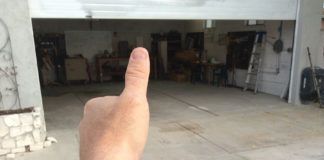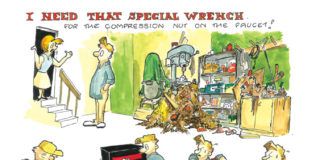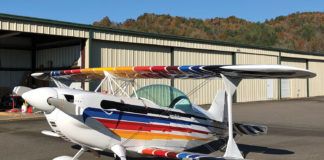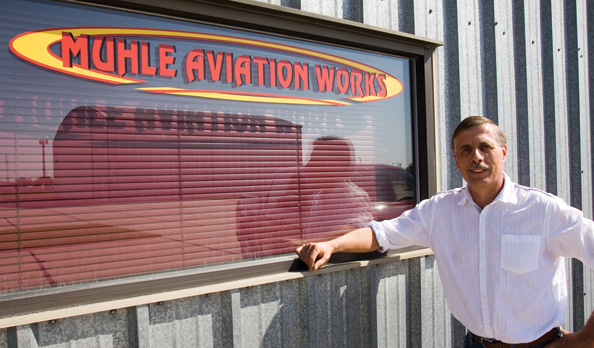
Heaven is in the eye of the beholder. For Paul Muhle it is an innocuous 6900-square-foot galvanized steel hangar at the municipal airport in Columbus, a quiet island of 21,000 good people in an ocean of corn and beans roughly 80 miles west of Omaha, Nebraska. Classic rock softly bathes his yellow-and-black trimmed, red-over-white Pitts, which waits patiently by the hangars yawning flap. Behind it is a 20×40-foot steel paint booth, complete with lights, filtered air and fire-suppression system. Where the booth connects to the back wall, a Jackson Pollock spattering of orange and blue and black drops decorates the floor under the mixing bench.
Just more than three years earlier Muhle Aviation Works was a homebuilders gauzy daydream of making a living by exercising his well-honed skills on other peoples airplanes. Now, on this late summer visit in 2009, a worn Piper PA-12 Super Cruiser waits for some new landing-gear tubing. Its space will soon be filled by a decades old Starduster in need of a thorough inspection, restoration and recover. It will be, Muhle hopes, the first of many like it.
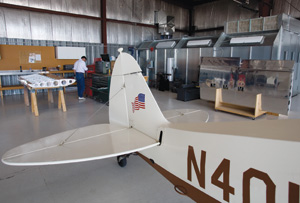
Framed by the tail of his next job, landing-gear work on a Piper Pacer, Muhle grabs a tool he needs to work on his RV-7 wing.
Given his experience, Muhles primary customer base-subsequent owners of Experimental/Amateur-Built aircraft, especially tube-and-rag models-seems obvious. But it only became clear over the past three years as he evolved from a homebuilder to a businessman. Its been a process, he says, much like the one that drives award-winning craftsmanship: Study the plans, make improvements where needed, delete the extraneous and do it right. Indeed.
Nothing about Muhle, or the hangar he shares with Lite Wings LLC, an LSA and Experimental aircraft sales, service and Sport Pilot training company, is out of place. Hand tools hang behind benches or hide in the rolling green steel tool tower. Each drawer reveals tools, from snips and screwdrivers to a Dremel, purposely placed for use as soon as Muhles fingers close around them. Under the benches, horizontal band saw, disk sander, drill press and almost finished RV-7A wings, the floor is clean swept. In the office a TV-VCR stands front and center on the uncluttered desk. Reading glasses are centered on top of a short stack of blue books for the King Schools A&P course.
Neatly turned out in jeans and a button-up shirt with sleeves rolled to the elbow, Muhle fits in his surroundings. His brown eyes are direct, steady above a well-trimmed mustache, now more salt than pepper. A ready smile turns self-conscious when he talks about his accomplishments. On the filing cabinet plateau a Lindbergh trio, two gold led by a silver, tower over a handful of International Aerobatic Club awards earned at local contests. Earning one Grand Champion gold Lindy award at EAA AirVenture Oshkosh is tough; three is unheard of. Yet here they are, with the third gold Lindy, for the Pitts that waits in the hangar, standing alone on a nearby shelf. Call them a rsum, the transcript of a home-schooled craftsman.
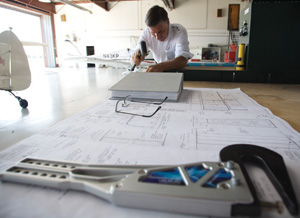
Muhle works on an aileron bellcrank for his RV-7 wing.
Muhle builds to fly, and he likes to compete, but only against himself. He submits his work to the scrutiny of the persnickety EAA judges not for recognition (which seems to make him both proud and uncomfortable), but for their feedback. I still think I can do better on the next job, he says, and the judges see things hes missed. His first airplane, the Acro Sport II, proves the point. It earned a silver Lindy as the 1993 Plansbuilt Reserve Grand Champion. Having addressed the judicial comments, Muhle and the plane earned the gold Lindy in 1994, followed by the One Design in 2000 and the Pitts S1SS in 2007.
All in the Family
The youngest of three boys (all pilots, inspired by the late Duayne Sr.), Paul and his middle brother, Kurt, were Muhle Construction, which built custom homes for nearly 30 years. As the Pitts neared completion and Muhle turned 50, the brothers decided it was time to call it a business. I was planning on semi-retiring from construction at 55, he says, but the head start is giving him more time and energy to build my dream.
Acting on the dream was a family decision, with a thumbs-up from daughters Angela and Jessica, both in college, and his wife of nearly 30 years, Sandy, who pushed me to go for it, Muhle says. She agreed to handle the finances and billing, a great plus for our family, and for the business, he says, because the necessary communication more fully integrates their lives, and makes it exhilarating. Not knowing whats going to happen adds to the excitement, but the expectations are realistic. Im not looking to make a great living, just a living doing something I really, really enjoy.
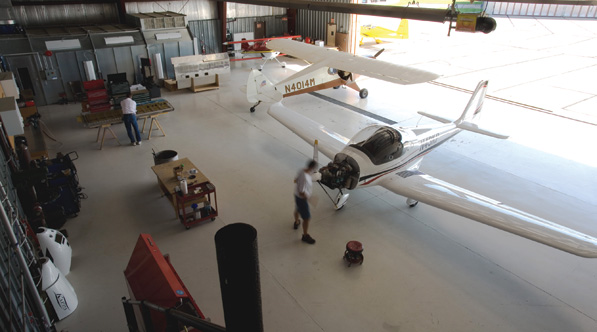
In their hangar at the Columbus, Nebraska, Municipal Airport, Muhle works on his RV-7 wing, while Frank Cuba finishes an oil change on his Kappa.
Quality, Craftsmanship and Customers
In his dream, Muhle knew exactly what he wanted to do: exercise aviation woodworking, welding and fabric finishing skills to his standards, a level of craftsmanship he summarizes as show quality. He butts a straightedge against the Pitts upper trailing edge like a trimtab, spanning the gap between the wing and aileron. The gaps are equal and trailing edges dead even, as are the other three ailerons. Such precision doesn’t improve performance, Muhle says, but details matter to him. The One Designs ailerons were close, but not perfect. I didn’t account for the paint, so they were off a thirty-second of an inch.
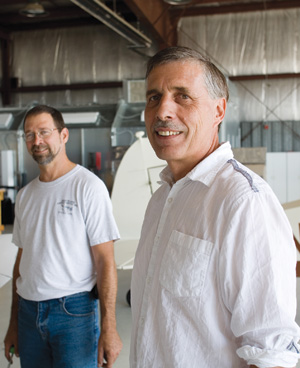
Hangar mate Frank Cuba (left) and Muhle.
When work doesn’t meet his standards, Muhle does it over. This doesn’t happen often, he says, but it does happen. On the Pitts he started with the small brackets. I just couldn’t make my welds look nice, he said. Id start an eighth-inch off from where it was supposed to be. After blaming his TIG welder and helmet lens, he finally discovered the problem. After a lifetime of 20/10 vision, he needed cheaters. To save time, reading glasses stand ready at every work area.
Safety also triggers a do-over. When a tornado flattened his backyard shop (but spared the house), an internal wall fell on the One Designs 9-G, all wood wings. They looked OK, but to guarantee their structural integrity Muhle routed the thin plywood skin from the bottom, and then applied new skin when all proved safe.
Working through potential customers, from the start Muhle knew he would not build an Experimental/Amateur-Built airplane for anyone but himself. An exhibition aircraft, like the orange and blue clipwing Cubby he built for an airshow pilot in 2008, yes, but not a 51% homebuilt. The RV-7A under construction (from a standard kit, naturally) is his. Sandy has a two-airplane rule, Muhle says, smiling. He sold the Acro Sport in 2006 and the One Design in 2008. Muhle calls the RV his first unselfish airplane. Traveling with Sandy is its mission, so itll have a glass panel and an autopilot.
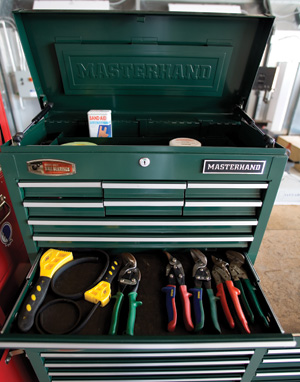
How a craftsman organizes his tools and materials says much about his approach to the job.
Clarity about potential customers developed when the Acros new owner brought it back for a minor repair. With roughly 20,000 amateur-built airplanes in the U.S. fleet, Muhle figured that like his first two airplanes, the original builders no longer owned many of them. Legally, their new owners could work on them, but it occurred to Muhle that many didn’t because they lacked time, desire or experience. And many A&Ps seemed to avoid homebuilts for reasons that started with liability and ended with unfamiliarity with the aircraft, their construction methods and the builders expertise.
First Things First
The Starduster is Muhles first client from this market. Built in 1975, the aerobatic single-seat biplane needs new fabric, a perfect opportunity to fully inspect, repair and restore the airplane. Muhle says the job should take four months, but we wont know until we get under its skin. With the owners approval, he can improve homebuilts unfettered by type certificate limitations. A canopy for the Stardusters open cockpit suggests other homebuilt design and/or building work that wouldn’t violate 51% parameters. And so for those interested, he could help get their flying machines in show-quality shape. If anyone knows what EAA judges are looking for, its Muhle.
As price conscious as the next person, Muhle knows time equals money at shop rates, but he says show quality work doesn’t take much more time than a good job-especially when working with an experienced craftsman, says Darren Zanardi, an A&P-IA, whos known Muhle for a decade. Ive seen him do work on an airplane in 40% less time than it would take somebody else, and do it to Muhles standards.
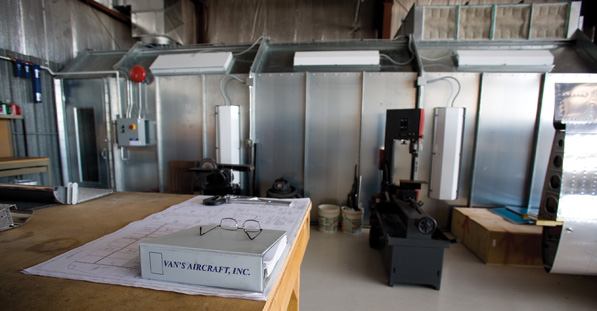
Muhles paint booth, a kit with lighting, filtered airflow and a dry chemical fire-suppression system, was intended for automotive work, but it holds most airplane components.
A 1993 Kansas State aviation program graduate, Zanardi led the Columbus FBOs maintenance operation in 1999. Restoring the FBOs Tri-Pacer, in 2000 he hired Muhle to teach his A&Ps fabric covering, a rarely used skill. When you’re doing things at a shop rate versus doing them on your own time, there’s a lot more cost on the learning curve than just materials, Zanardi explained. He started Liberty Aviation in 2003, and maintaining 25 to 30 spray planes accounts for 90% of his business. When someone hits a goose or power line, he often hires Muhle to help with the sheet-metal repair and finishing. Muhle Aviation Works also gets all the fabric work, mostly repairing the tail feathers of older spray planes.
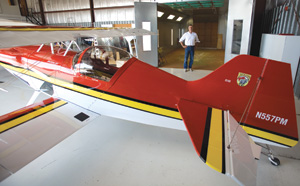
Muhles EAA Grand Champion modified Pitts guards the door to his paint booth.
Zanardi also signs off Muhles work on certified airplanes such as the Citabria wings he repaired in 2007. That job taught Muhle two things: Not every owner wants show-quality work-an airworthy repair will do, thank you very much-and Muhle Aviation Works would need more space than his home shop provided.
In a similar situation was Frank Cuba, who had just added Sport Pilot training to his LSA and Experimental aircraft sales and service business, Lite Wings. Airport acquaintances, both knew that the Nebraska Public Power District was selling its King Air hangar to the highest bidder. Neither needed all of the room it offered, so they agreed to coordinate their bids and go 50/50 partners in Hangar 15 LLC if they got it. There were three bids, and Muhle won in more ways than one, he says. Before making plans with Cuba, his bid was $60,000 higher. The partners set up shop in January 2008.
Becoming an A&P
Of all the components needed to build the business, earning his A&P certificate made Muhle the most anxious. He needed it to work on store-bought airplanes (with Zanardi signing off the required inspections), it would enable him to conduct and sign off annual condition inspections on homebuilts, and it was a professional benchmark. Still, the last time he had been in school was in 1975.
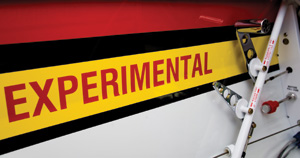
Show-quality work is about the details: The accent stripes on the Pitts are the same inside and out. And building light is something that can be done with style.
School might have been easier, but he couldn’t afford two years, 18 months of full-time classes at an FAA-approved A&P school. So he planned to study on his own, qualify on the experience gained in building his airplanes, and attend a weekend prep course before taking the three knowledge tests-General (60 questions in two hours), Airframe and Powerplant (each 100 questions in two hours)-just before Christmas 2007. It didn’t quite work out that way.
For guidance, Muhle called the FAA Flight Standards District Office in Lincoln, Nebraska. Its maintenance inspector, Tom Ronk, had never heard of earning an A&P through practical experience, Muhle says, but he was a real sharp fella, and he quickly kept his promise to check into it, and then to send the necessary information and paperwork. (Muhle has since learned this call is an important first step, because each FSDO has its own guidelines for giving a thumbs-up.)
Zanardi was with him at every turn, Muhle says, and I wouldn’t be where I am today without him. Converting the experience of building three airplanes into at least 30 months of practical experience, concurrently performing the duties appropriate to both the airframe and powerplant ratings required by FAR 65.77(b) was the first challenge. Each month equals 160 hours of experience tallied in five categories: General, Airframe Structures, Airframe Systems & Components, Powerplant Theory & Maintenance, and Powerplant Systems & Components. Each one has up to 12 topics, subjects such as basic electricity and physics, corrosion control, wood structures, welding, landing gear, fuel systems, engine inspections, lubrication and propellers-and Muhle needed to show experience in at least half of them in all five categories.
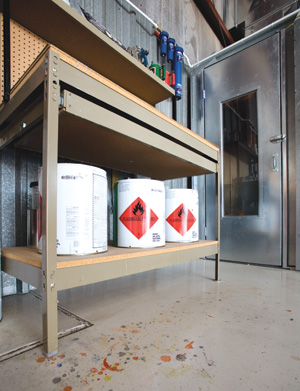
The paint-mixing station is next to the paint-booth door. The aerobatic Cubby christened the booth, and as the drips on the floor suggest, it was orange, blue and black.
Not counting the RV project, Muhle has 14 years of experience: 54 months for the Acro Sport (January 1986 to June 1992), 48 months for the single-wing One Design (November 1994 to November 1998) and 66 months for the much-modified Pitts (December 2001 to June 2007). Overwhelmed by the daunting task of parsing into the categories and topics on the FAA form, Zanardi suggested a simpler method, and the FAA agreed.
Zanardi often stopped by Muhles shop on his way home from work (and the next thing you know…its two in the morning!), so he was familiar with the Pitts. With this work fresh in their minds, they started listing blocks of hours dedicated to each area on the FAA experience list. With that complete, they applied the experience with the Pitts to Muhles first two airplanes. Getting the time in most areas was easy because Muhle had built three airplanes, Zanardi says. If hed built only one, it would have been a bit different.
Muhle was way over in some categories, right on in others and short in both powerplant categories. Splitting the ticket was an easy decision. Airframe covers most of Muhles work; the powerplant experience would come with time. With his experience FAA approved, Muhle spent a lot of time with John and Martha King instead of a weekend test-prep course. When he earned consistent 90s on the practice tests, he took them for real (80 on the General and 85 on the Airframe) in September 2009. It went much better than I thought, he said. When the [computer testing center] asked if I was ready, I couldn’t remember a thing; then the first question appeared…Oh, I know that one, and the next one appeared, and I knew that one. That got my confidence back up.
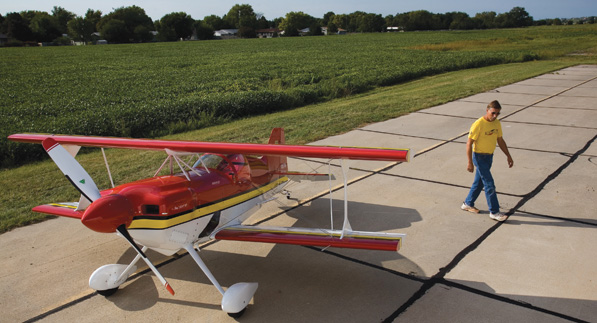
Nebraska farm fields all but surround the Columbus Municipal Airport.
Muhle was less worried about the oral and practical tests, but he spent a lot of time with Advisory Circular 43.13-1B to make sure his methods were acceptable to the FAA. He had time because Jon Leever, the closest designated maintenance examiner, was 300 miles to the west, in Sidney. On the Western Nebraska Community College faculty, Leever only tested practical-experience applicants on weekends (and his last such test had been in 1991). He was excited about the test, Muhle says, and that helped calm pretest jitters. I asked if I could use his books, because there’s not a lot of room in the Pitts, and he was fine with that.
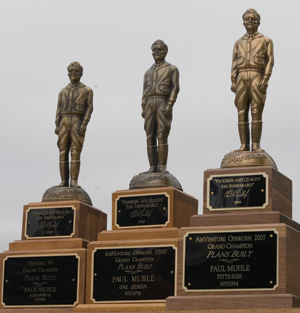
Earning one Grand Champion gold Lindy at EAA AirVenture Oshkosh is hard, especially in the plansbuilt category. Muhle has three, one for each of his creations.
Getting It Done
At Muhles request, the three-hour oral took place 30 minutes after he landed on a Friday afternoon in late October 2009. It touched on everything, he says, and so did the 12-hour practical test that started at 7:30 the next morning. It included the required core competency items: Install and remove two types of rivets; check or set control cable tension; determine inspection requirements based on a maintenance record; inspect a brake; install a hydraulic seal; service a fuel strainer; and troubleshoot an electrical problem. Overall, the practical test was challenging, and that was good for me, Muhle says, with a note of confidence in his voice and a rare highlight of pride.
In the next breath he talks about things still to be done, getting with his web guy to update his web site and getting started on the Starduster, which flew in the day after he passed the airframe practical test. Part of the excitement of seeing a dream through is that, You don’t know whats going to happen next, Muhle says. But one thing is sure: Every day I come here to the hangar, I come with a smile on my face.
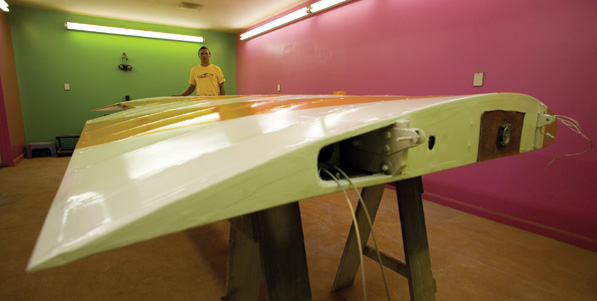
In the paint alcove of his home shop, Muhle decided he needed more room while repairing some fabric damage on a set of Citabria wings. His daughter repainted the walls for the high school graduation party held in the shop.
For more information, call 402/276-2589 or visit www.muhleaviation.com.


